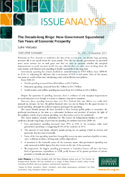
Politicians in New Zealand are wedded to the idea of the activist state, but despite huge spending increases life is not much better for most people. Over the last decade, government has provided more social services but at such great cost that we have to question whether the marginal improvements in social outcomes justify the cost, whether there are other ways to bring about the same results, and whether such spending is fiscally responsible in the long term.
Government spending has almost doubled in nominal terms to $70.5 billion from 2000–01 to 2010–11. Adjusting for inflation, this is an increase of 57% in real terms. Most of this money was spent on social welfare and introducing costly and ineffective new policies. From 2000–10:
- Health spending increased from $6.6 billion to $13.5 billion.
- Education spending increased from $6.1 billion to $11.7 billion.
- Social security and welfare spending increased from $13.2 billion to $21.2 billion.
Despite the quantum of spending increases, there is evidence of only marginal improvement in social indicators even though it is easier to disprove than prove causation.
Moreover, these spending increases have seen New Zealand slide into deficit very easily with reduced tax revenue. In fact, the global financial crisis was not to blame for the great increase in recent spending, although the political response prolonged the spending.
This report should prompt all those involved in New Zealand public policy to reconsider the profound attachment to the state as a substantial facilitator and provider of services. In light of the negligent results of government spending, new alternatives need to be considered.
This report updates research undertaken by The Centre for Independent Studies in 2007 and confirms a decade-long binge of government spending. It confirms that from 2000–10:
- Core government spending increased from 29% to 35% of the economy, while total government spending is a staggering 49.9% of the economy in 2011.
- The amount of cash churn, whereby people paying tax are getting it back in services and payments, has increased drastically.
- Some of the clear spending items have been public sector pay rates, numbers of public servants, and a stubborn incidence of long-term welfare dependency.
- A recession in the tradeable sector of the economy meant that government spending not only increased in dollar figures but also relative to the size of the economy.
- By comparison, the biggest spending government in Australian history still has a far lower level of government expenditure to GDP, partly because of far greater provision of private providers in health and education. Is life much better than it was a decade ago? This is the question that governments should constantly ask themselves. Social indicators are not a perfect science and there are lags, but if policies are going to be put in place that help some facet of life, their success or otherwise needs to be measured and weighed. Unfortunately, on the evidence available, New Zealand’s prosperity since 2000 represents a decade that wasted the proceeds of a painful reform process, while simultaneously wasting the proceeds of the economic boom of the 2000s.
Luke Malpass is a Policy Analyst with the New Zealand policy unit at The Centre for Independent Studies.










